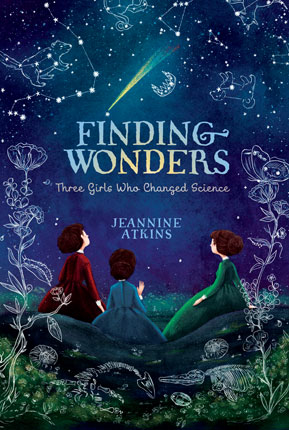Full Text Reviews: Booklist - 05/15/2016 *Starred Review* From the author of Borrowed Names (2010), this three-part novel in verse vividly imagines the lives of three girls who grew up to become famous for their achievements in science. “Mud, Moths, and Mystery” opens in Germany in 1660 with Maria Merian as a girl, closely observing insect metamorphosis. Pursuing her interest in nature throughout her life, she even traveled to South America to observe wildlife. “Secrets in Stones” tells of young Mary Anning, who in the early 1800s began collecting fossils from cliffs near her home in Lyme Regis, England. Despite poverty and limited education, her significant discoveries and observations contributed to paleontology at a pivotal time. “Mapmaker’s Daughter” begins in 1831 with Maria Mitchell stargazing through her father’s telescope on Nantucket. Later, she discovered a comet and became a college astronomy professor. Atkins has a knack for turning a phrase, such as “Certainty is like a pillow / she learned to live without,” or “Coughs scrape the air, as if Pa breathes through a grater.” Science is woven through the narratives, but within the fabric of the characters’ daily lives and family struggles. While the Mary Anning narrative is the most haunting, each of these three perceptive portrayals is original and memorable. - Copyright 2016 Booklist. Bulletin for the Center... - 06/01/2016 In the scramble for STEM curricular materials that celebrate the contributions of women scientists, Atkins’ offering of three extended free-verse biographical poems is distinguished for both content and elegance. Maria Sibylla Merian, of seventeenth-century Germany, not only discovered through close and secret observation the life cycle of the moth but made her discovery public through artwork, despite the guilds’ ban on women as professional painters. Mary Anning, of nineteenth-century England, took up her injured father’s avocation of fossil hunting, becoming a family breadwinner upon his death and the first to discover and excavate an ichthyosaur and plesiosaur. Maria Mitchell, of nineteenth- century Massachusetts, learned from her father mathematics and astronomical calculations used by mariners. She was skilled at chronometer repair by the age of thirteen, won a Danish prize for the discovery of a comet, and became a professor of astronomy at Vassar. Readers are lured in by strong openings and vivid storytelling. Maria Merian knows that girls displaying unusual curiosity may be suspected of witchcraft; Mary Anning chips away at perilously slippery cliffsides in the rain with her father; Maria Mitchell watches her close-knit family fracture when her brother goes off to sea against their father’s wishes. Presenting this trio side by side allows readers to compare not only the inroads women have made in science but also how scientific thought has matured over the decades, shedding superstition, adopting rigorous observation, and gradually winning public acceptance of its methods and discoveries. With each chaptered poem a gem in its own right, this collection will appeal to poetry lovers as well as awakening scientists. Selected bibliographies are included. EB - Copyright 2016 The Board of Trustees of the University of Illinois. School Library Journal - 06/01/2016 Gr 4–8—A collection of fictionalized stories in verse about three real women whose innovations influenced modern science. Maria Merian (1647–1717) was captivated by the metamorphosis of the caterpillar. Despite common superstitions about shape-shifting magic, Merian secretly collected and observed first silkworms, then caterpillars, to document the science beneath the mystery. She grew up to create incredible paintings of insects, including butterflies and other wonders of the natural world. Mary Anning (1799–1847) shared her father's curiosity about fossils entombed in the rocks of their New England home. Her findings were painstakingly excavated by chiseling away each layer of rock. Maria Mitchell (1818–89), who tirelessly watched the heavens for both consistency and change, discovered a new comet and became one of the first women to be accepted into the American Academy of Arts and Science. Atkins skillfully conveys the importance of these women's scientific contributions to the world, while also imagining the complexities of their lives as daughters, wives, and sisters during times when female scientists were marginalized or ignored. The verse is effective—evocative and beautiful. VERDICT Highly recommended for fans of poetry about the natural world and the lives of real people.—Patricia Feriano, Montgomery County Public Schools, MD - Copyright 2016 Publishers Weekly, Library Journal and/or School Library Journal used with permission. Loading...
|



